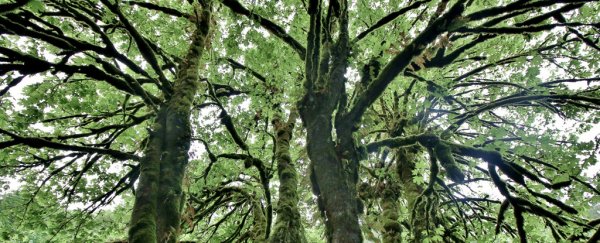The largest ever study of tropical forest regrowth has discovered that new-growth rainforests can sequester as much as 11 times the annual amount of atmospheric carbon as old-growth forests.
New-growth forests - also called secondary forests in contrast to old-growth (primary forests) - grow quickly to maximise their access to sunlight, and in doing so, draw large amounts of carbon to help with photosynthesis. According to an international team of scientists, this rapid regrowth saw half the forests in the study attain 90 percent of old-growth forest levels within 66 years.
"Regenerating secondary forests could play a critical role in carbon sequestration and climate change mitigation," said Daisy Dent from the Smithsonian Tropical Research Institute (STRI) in Panama and the University of Stirling in the UK. "However, previous studies have tended to focus on single sites. This study brings together data from many sites that span the Neotropics. We illustrate that secondary forests are highly productive and resilient."
The scientists examined a huge amount of secondary forest to arrive at their findings, encompassing eight countries, 45 sites, 1,478 study plots, and more than 168,000 trees. They assessed rainforests in the full latitudinal range of the tropics, in between 20 degrees north in Mexico to 22 degrees south in Brazil.
The findings, reported in Nature, suggest that regenerating forests after 20 years of recovery are capable on average of a net carbon uptake 11 times that of Amazonian old-growth forests – and twice that of selectively logged Amazonian forest sites.
"According to this analysis, tropical secondary forests have enormous potential for removing carbon from the atmosphere," one of the team, Susan Letcher from Purchase College State University of New York, wrote at The Conversation. "The rate of biomass recovery varies widely across the region, with the fastest regrowth in areas with high rainfall. The median time for a forest to reach 90 percent of old-growth biomass levels was 66 years, but recovery can be much faster in some areas."
The extent to which tropical regrowth bounces back after either natural or human-caused deforestation – for example, natural disasters such as fires and floods, or logging and agricultural land-clearing – isn't just a win for carbon absorption calculations. It's also a broad ecological victory.
"Secondary forests can harbour a high diversity of ethnobotanically important species that can be used for medicines," writes Letcher. "They can serve as extractive reserves, where limited harvesting of timber, game animals and other forest products will prevent the exploitation of resources in vulnerable protected areas. They protect watersheds and prevent erosion."
But just because new forests offer dramatically efficient carbon absorption doesn't mean old-growth should be cleared, the researchers warn. After all, the rapidly accumulated carbon sequestered when forests are young ends up being stored in the biomass that eventually (hopefully) becomes old-growth.
"Shifting focus to the conservation of regenerating forests should not take away from the urgent imperative to conserve the remaining uncut tropical forest," writes Letcher. "The clearing of old-growth tropical forests is a major source of human-induced greenhouse gas emissions, second only to fossil fuel combustion. Clearly, keeping the carbon that's currently stored in intact tropical forests from being released to the atmosphere should be a priority."
